Chicken and Waffles: Key Temps for Perfection
Do you love fried chicken? Of course you do—it’s an almost objectively tasty dish: crispy, spicy breading surrounding juicy, tender chicken. Yum. And how do you feel about waffles? Toasty, crispy-fluffy with a hint of sweetness in the batter—also delicious, right? Why not put them together! Chicken and waffles is a classic American food in both the SouthernsSoul-food and Pennsylvania-Dutch traditions, the former with fried chicken, the latter with a sort of shredded-chicken stew served over the top. The fried chicken version is the one that has gained wide popularity across the U.S., spreading lie a savory-sweet wave since the beginnings of the 20th century.
Today, we’ll cover a Mexican-food inspired version of this classic dish that adds a third classic element into the mix—you guessed it, bacon! Needless to say, we couldn’t resist. Along the way, we’ll cover all the thermal angles and critical temperatures you need to know to get delicious chicken and waffles—no matter the recipe—at home.
Contents:
Waffle iron, waffle batter
There are two keys to a good waffle: a properly made batter and a properly heated iron.
Waffle iron
There are no two ways about it: the best way to get delicious waffles is to have a properly heated waffle iron. And by properly heated, we mean 375°F (191°C). Only by heating your waffle iron enough, but not too much, can you get that crisp outside and that steamy inside that everyone wants in a waffle. Use a Hi-Temp Industrial IR w/Circle Laser infrared thermometer (or other IR thermometer) to take the temperature of your waffle iron before you add the batter. But that’s not all! Actually cooking the waffles will lower the temperature of the waffle iron, so check the surface temperature after cooking each waffle before adding more batter to the iron. If it’s not 375°F (191°C), let it heat another few minutes to get up to temp. Then proceed with the cooking and get the crispiest, best waffles ever. Trust me, this is one step where obsessing over temperature pays huge dividends.
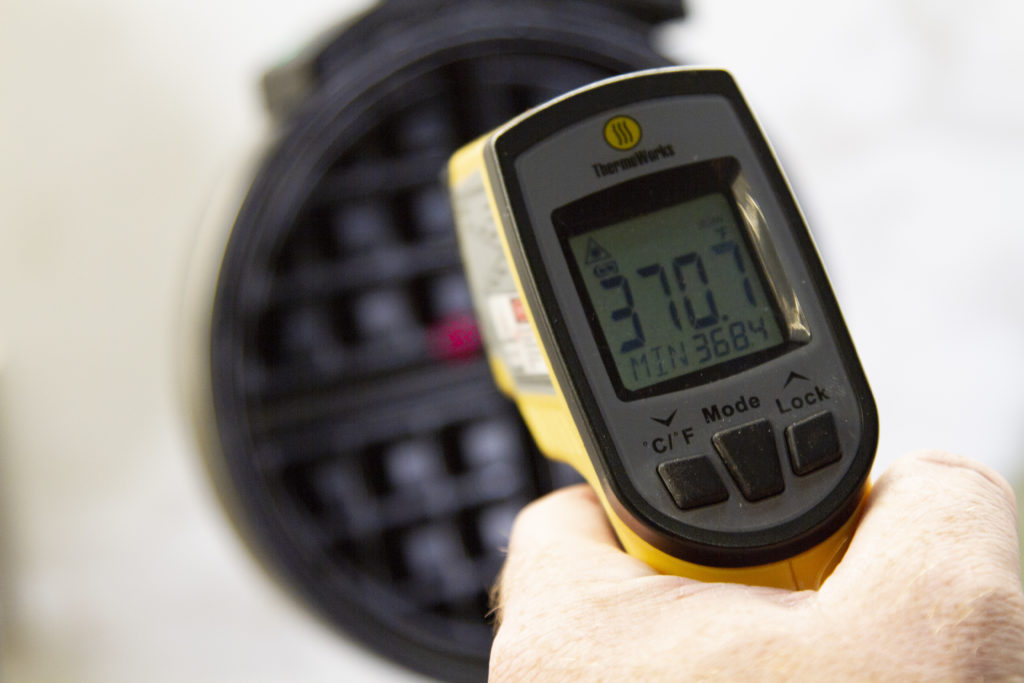
Waffle batter
Of course, even with a properly heated iron, you still need a good waffle batter, to begin with. Waffle batter should be thick and even kind of lumpy. A better that is too thin will not “stand up” in the waffle iron, and you won’t get those deep, delicious squares to fill with sauce. And if you’re going to be putting a bunch of syrup and butter (or, in the case of our recipe below, guacamole and salsa) on top, you need something that can support it. Thin-bodied waffle batter won’t do it.
That being said, you do want your waffles to be tender, almost cake-like. Chewy waffles aren’t the goal. To avoid chewy waffles, don’t use bread flour in the waffles, and don’t over-mix. Mixing flour with water produces gluten, and gluten makes bread chewy. To ensure tender waffles every time, mix the ingredients only until they’re just combined. That thick batter with some lumps will be perfect.
Pro-tip: if you let your waffle batter rest for 10-15 minutes after mixing it, the gluten that has been formed already will relax some, improving the finished product of the waffle.
Frying Chicken
Frying chicken is all about getting the meat cooked to a proper internal temperature without overcooking the breading or letting it get oil-logged and soggy. That means a temperature of 350°F (177°C). By using an accurate leave-in probe thermometer like the ThermaQ®, you can keep track of the oil heat with certainty. Frying your chicken in small batches is also important because adding wet chicken to hot oil will lower the temperature dramatically as the water quickly transforms to steam. If you add too much battered chicken, the temperature will drop too far, and the breading will get soggy as the oil comes back up to temp and the chicken cooks. By using the ThermaQ, you can monitor the oil temperature in real-time, adjusting it as needed to throughout the cook. And, as with the waffle iron, be sure to let the oil get back to its proper temperature before adding each subsequent batch of breaded chicken.
Beyond that, any good breading recipe will do. We’re using a scrumptious one from our friends at SeriousEats.
Note: the temperature we cook the chicken to in this recipe is lower than that usually recommended. However, as we’ve discussed before, the lethality of salmonella (or any other bacteria) is a function not only of temperature but also of time. A longer hold time at a lower temperature is equivalently lethal to higher temps for shorter times. The lethality as we heat the chicken up to our pull temp is enough to make the chicken safe, especially with the re-heat that we give it at the end.
Candied bacon
The recipe we will be following here will be mostly savory, but with a hint of sweetness from candied bacon. Candying bacon is a delicious way to make friends and is really quite easy. Lay out your bacon on a cooling rack set in a cookie sheet and cook it at 400°F (204°C) for about 10 minutes, or until it just starts to firm up. Then brush it with honey (mixed with ancho chili powder in this case), and bake it for another 4-5 minutes. Let it cool outside of the oven into candied, delicious bacon.

Loaded Mexican Fried Chicken and Waffles Recipe
As I mentioned, this recipe is based on the one from SeriousEats, and while the ingredients list is long, it’s well worth the effort to make this dish. Even if you don’t follow this particular recipe for your chicken and waffles, remember that the thermal principles still apply no matter what waffles you’re cooking.
Ingredients
- For the chicken
- 6 skin-on, deboned chicken thighs
- 4 C buttermilk
- 1 Tbsp hot sauce
- Fresh juice of 2 limes
- 1 Tbsp plus 2 tsp kosher salt, divided
- 1 C yellow cornmeal
- 1/2 C masa harina
- 1/2 C all-purpose flour
- 1 tsp baking powder
- 2 tsp ancho chili powder
- 2 tsp ground cumin
- 2 tsp paprika
- 1 tsp garlic powder
- 1 tsp granulated onion
- 1 tsp freshly ground black pepper
- 1 tsp granulated sugar
- Oil, for frying
- For the Waffles:
- 2 C buttermilk
- 2 large eggs
- 1/4 C butter, melted and cooled
- 1 C all-purpose flour
- 1 C masa harina
- 1 C yellow cornmeal
- 2 Tbsp granulated sugar
- 1 Tbsp baking powder
- 1 tsp kosher salt
- 1/2 C diced roasted green poblano peppers (about 4 poblano peppers), or 7 oz drained and diced canned green chilis
- Nonstick cooking spray
- To Serve:
- 1 lb thick-cut bacon, candied according to instructions above
- Guacamole
- 3/4 C salsa
- 1/2 C Mexican crema or sour cream
- Fresh cilantro, sliced green onion, and fresh chilies to garnish
Instructions
For the chicken
- Combine buttermilk, hot sauce, lime juice, and 1 tablespoon kosher salt.
- Soak chicken in buttermilk bath for 1 hour.
- In a wide, shallow bowl, combine the cornmeal, masa harina, flour, baking powder, ancho chili powder, cumin, paprika, garlic powder, granulated onion, black pepper, sugar, and 2 teaspoons of salt. Mix together thoroughly.
- Remove the chicken from its milk bath and let drain, keeping the bowl of buttermilk!
- Working a piece at a time, coat each piece of chicken in the breading, then dip it back in the buttermilk, then recoat with breading. This double coat makes a thicker, crispier crust.
- Allow the chicken pieces to sit for 15 minutes for the breading moisture to equilibrate.
- Heat 2” of oil in a deep, thick-bottomed pan to 350°F (177°C), setting the high-alarm on your ThermaQ to sound when the temperature gets there.
- Cook the chicken 2-3 pieces at a time until their internal temperature reaches 150°F (67°C) as read on a Thermapen®.
Starting to heat the oil…frying the chicken…verifying the temperature - Drain the chicken piece on a paper towel-lined sheet and cook the rest of the chicken, making sure that proper frying temperatures are attained between cooks.
- Let cool to room temperature, set frying oil aside.
For the waffles
- Combine the dry ingredients in a large bowl.
- Whisk together the wet ingredients (but not the chilies) in a separate bowl.
- Pour the wet ingredients into the dry and stir to just
- Fold in the green chilies and let stand for 10 minutes while you heat the waffle iron.
- Once the waffle iron temperature reaches 375°F (191°C)—as measured by an infrared thermometer—spray it with nonstick cooking spray and add a large mound of batter to the center of the iron. Close the lid and cook!
- When your waffle maker indicates doneness, check the surface of the waffle to make sure it is golden brown and crisp. If it’s not done yet, close it and let it cook further.
- When the waffles are done, remove them to a plate and tent with foil to keep them warm.
- Re-verify the temperature of your iron, and continue cooking all the waffles.
This iron needs to heat up before you cook more waffles on it.
To serve
- Reheat the oil to 375°F (191°C)—hello ThermaQ!— and quickly reheat the chicken by frying it for about 2 minutes. Drain on paper towels.
- Plate the waffles. Spread with guacamole, top with bacon, then a piece of chicken. Top with salsa, crema, and garnishes.
One great thing about classic dishes is that they’re fun to play with, to reinvent. In this case, translating Soul food into a Mexican flavor dialect yields delicious results. But no matter the food language, the thermal principles remain the same. And whether your waffles be Pennsylvania Dutch or green-chili corn, you still need a hot waffle iron to cook them right. Tools like the IR-IND, the ThermaQ, and the Thermapen® give you the power to cook in any language with great results every time.
Shop now for products used in this post:


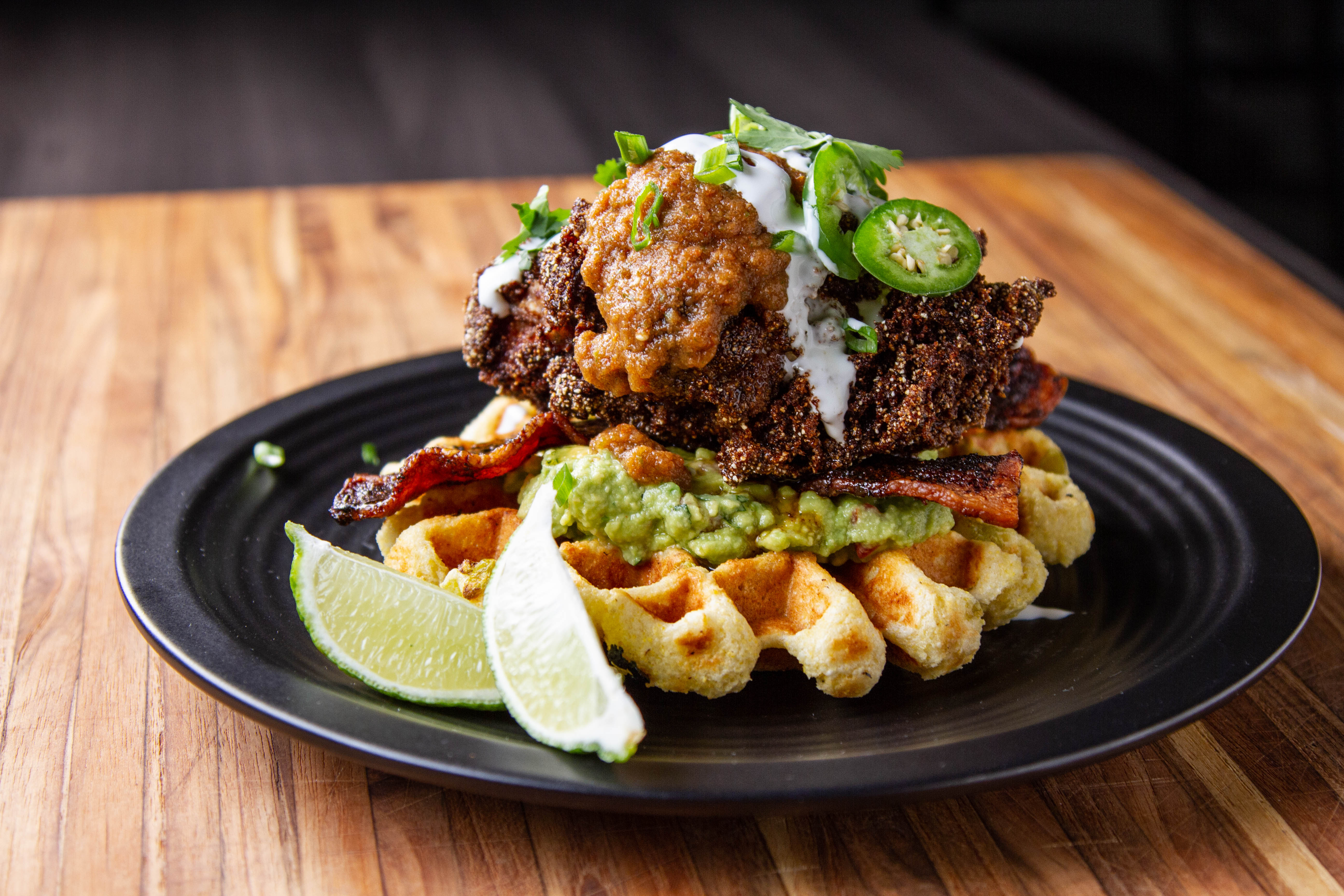
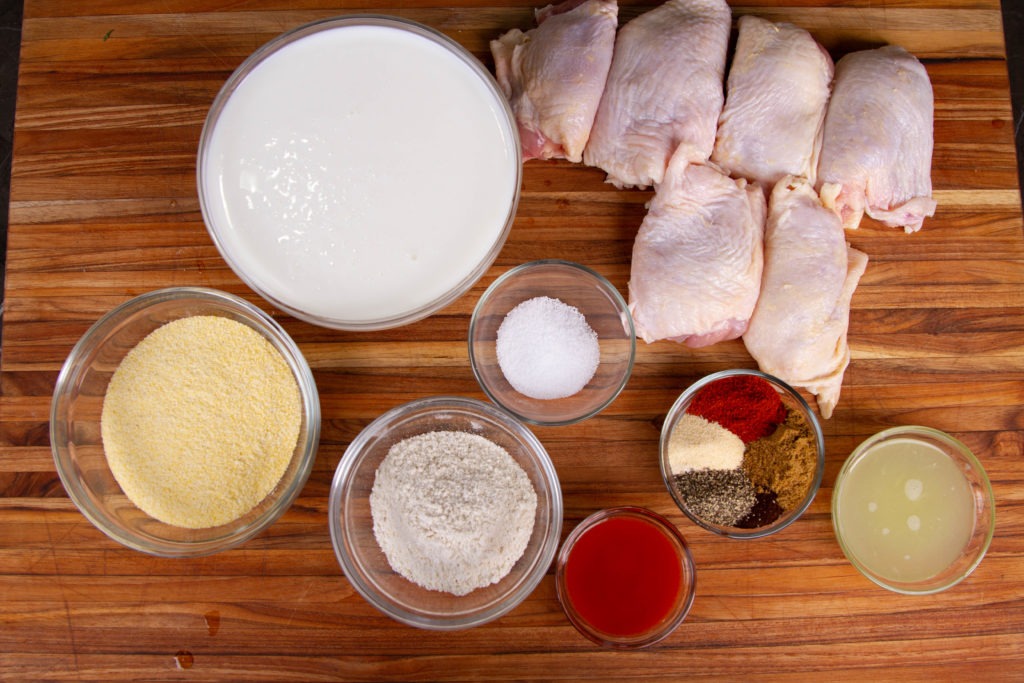
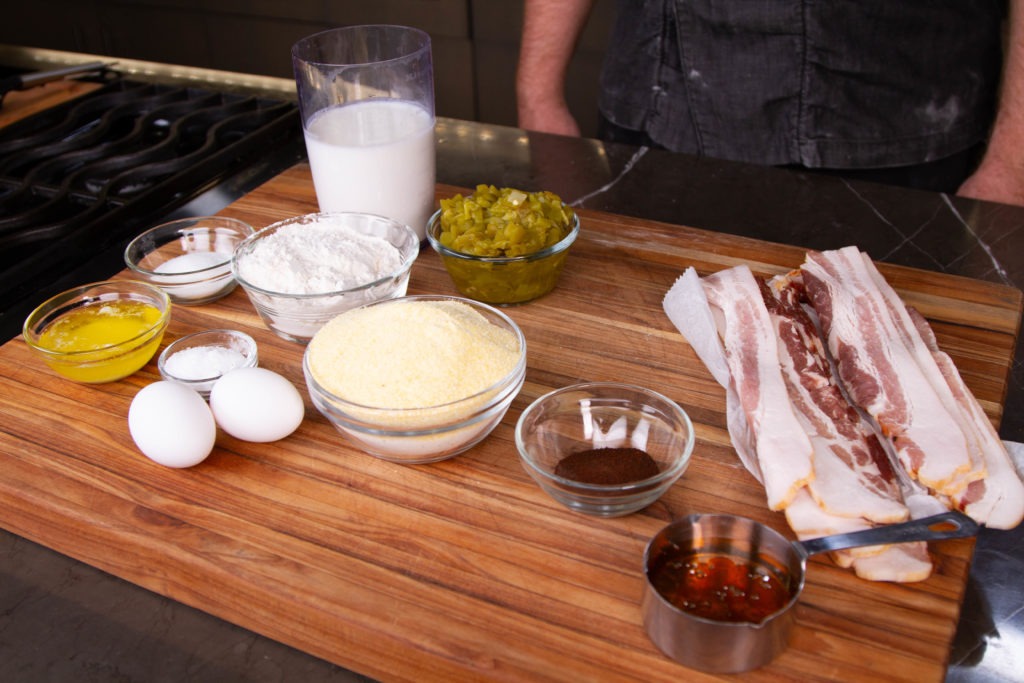



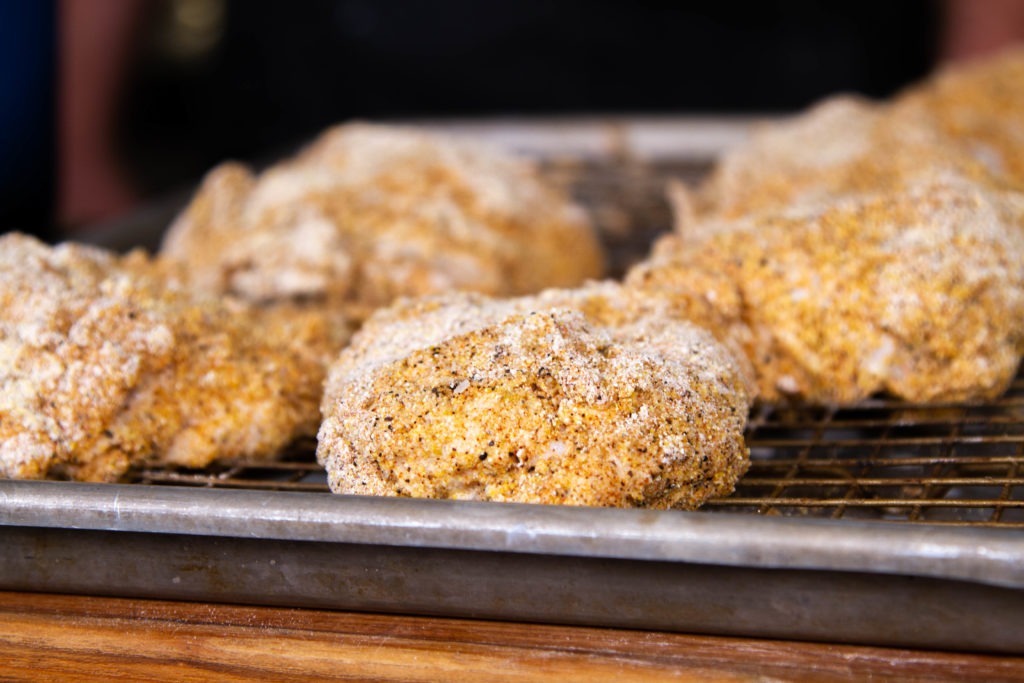


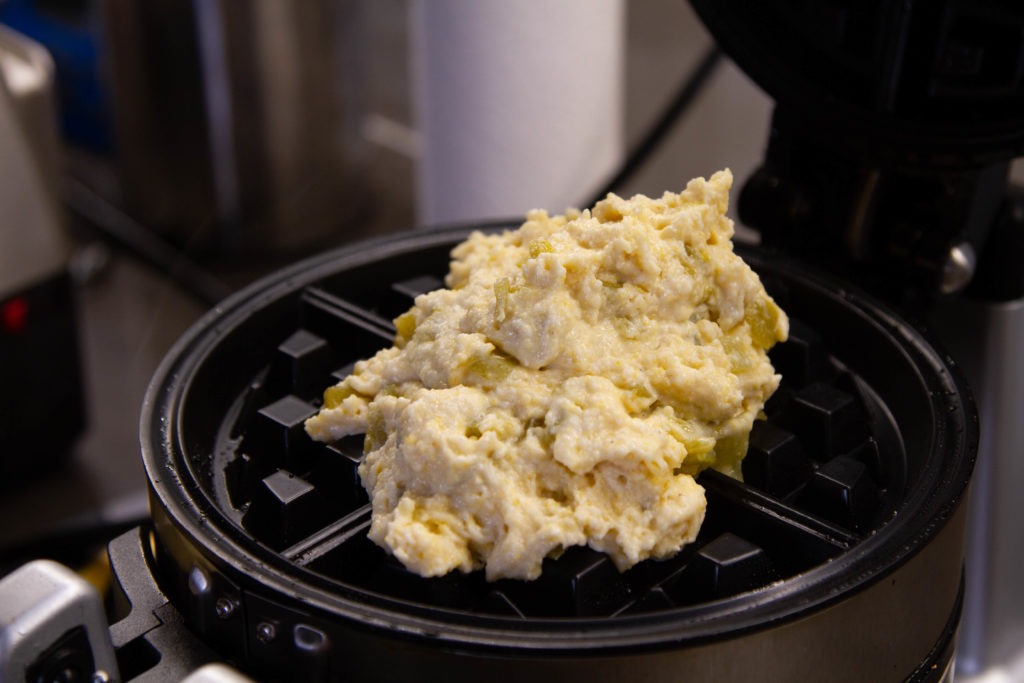
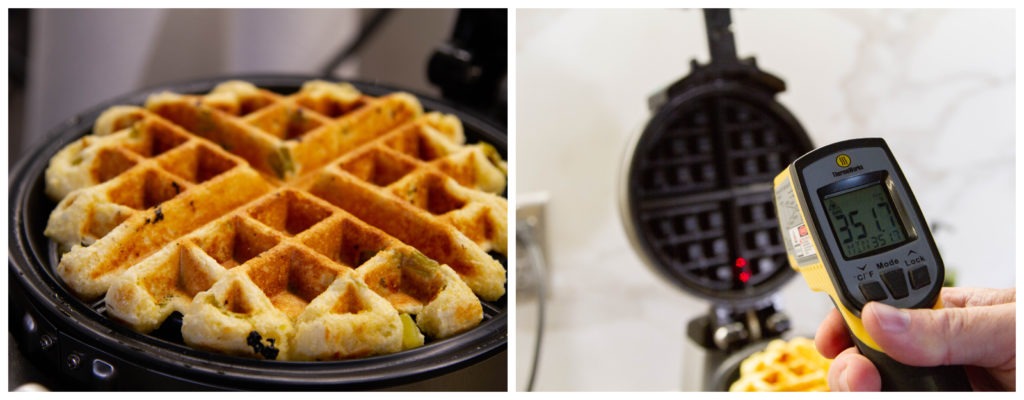
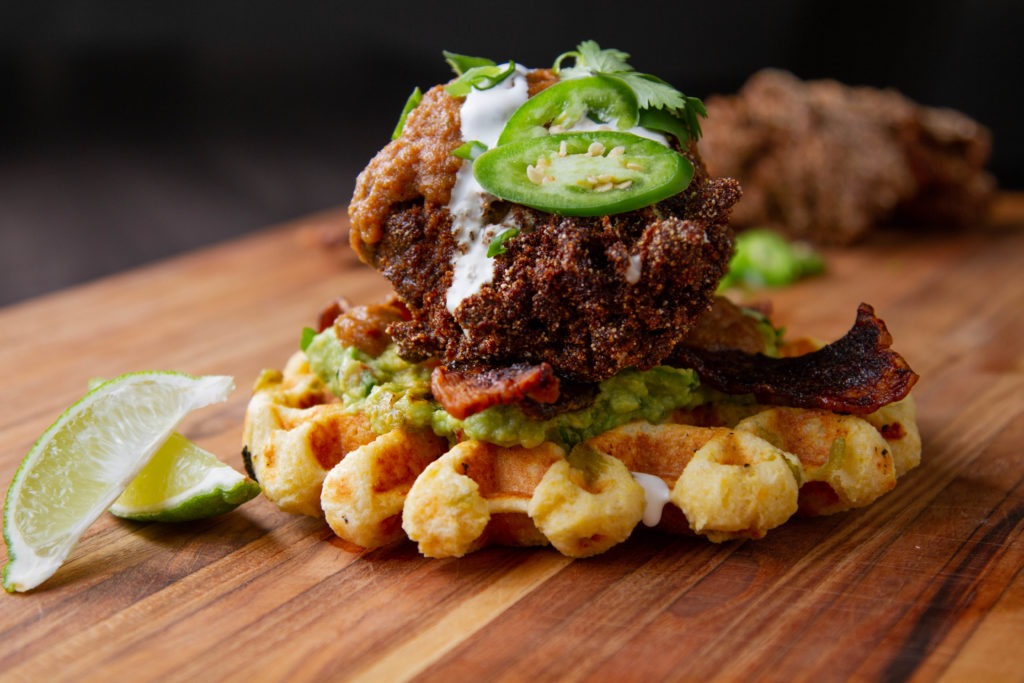
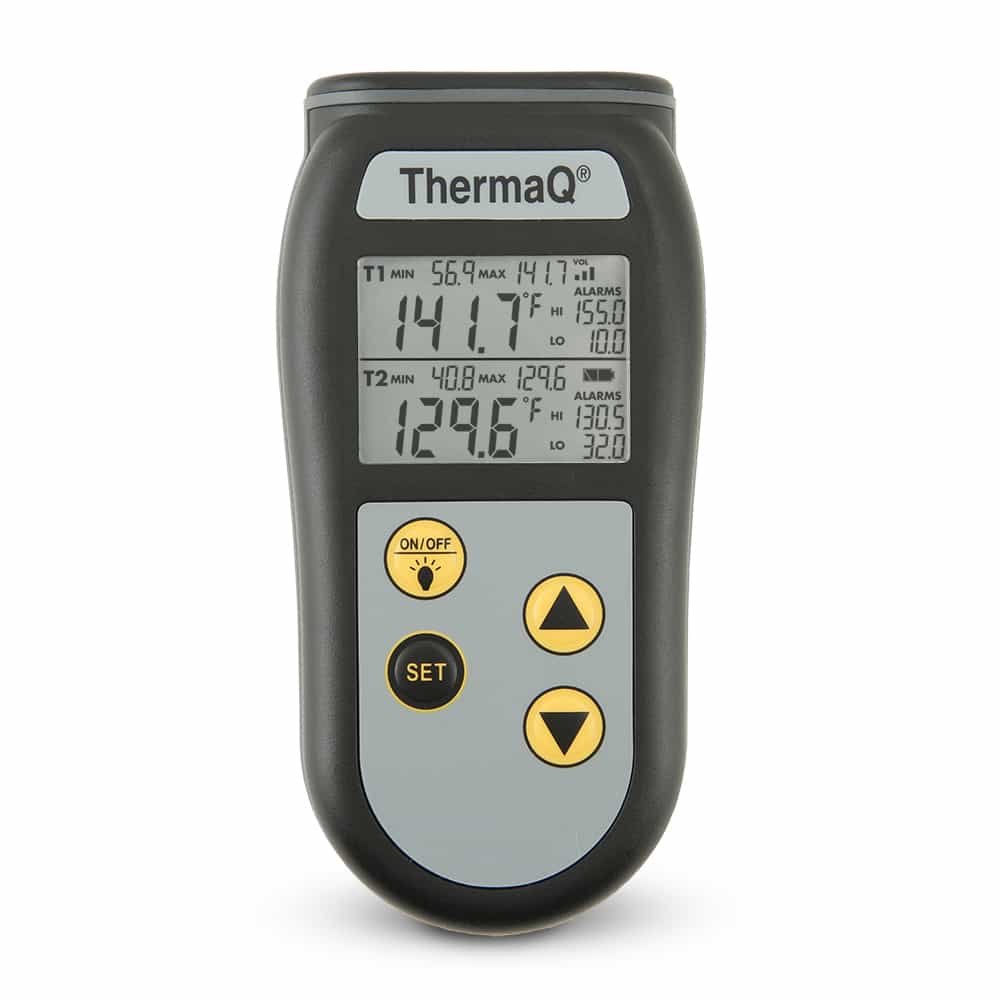
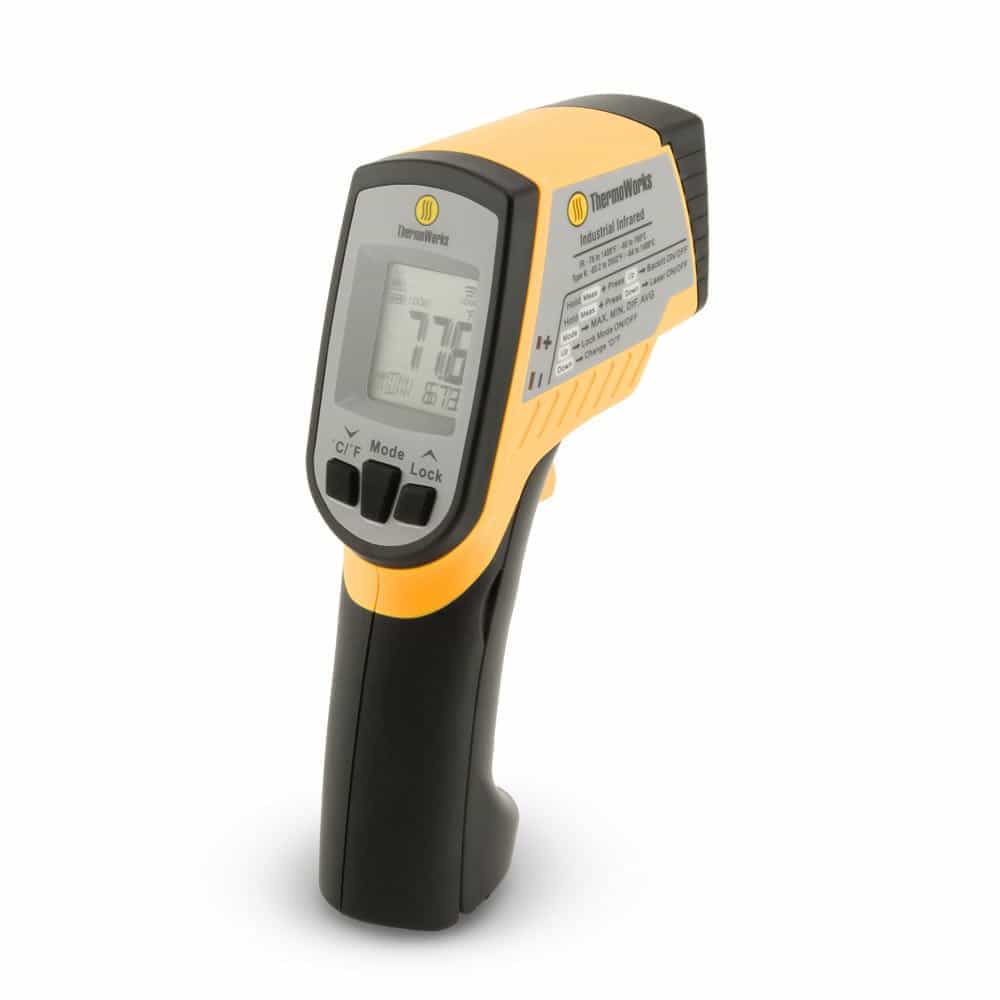
I would never cook bone in chicken to 150*,it will not be done around the bone. You may think it’s too much, but I cook bone in pieces untill it’s IT temperature is 200* or on a leg quarter, until the drum turn easily if you don’t have a thermometer. It will be moist and fall off the bone. You will not have to gnaw the meat off and you won’t find any pink around the joint.
Boneless breasts are different. Take them to 165*
I’ve never heard of anyone cooking bone in chicken, or any chicken for that matter, to only 150*. Maybe it’s a typo?
Bobby,
The recipe actually calls for boneless chicken, though I may have phrased that poorly. You are right that cooking dark meat chicken to a higher temp is fine, but I recommend something in the 175°F range. You might want to check out our post on pink chicken temps!Granted, it may still be offputting, but it can be safe!
BTW, the recipe sounds very good! I’m going to try it.